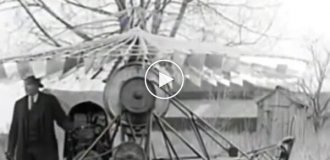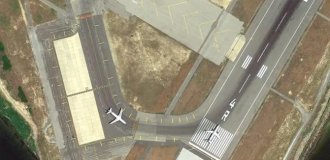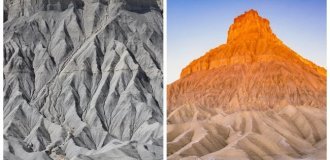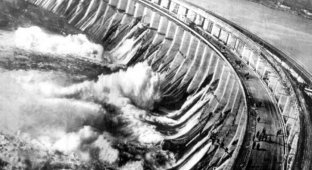Dam destruction: explosion of the Dnieper Hydroelectric Power Station, August 18, 1941

From the “reprinter”: After the accident at the Sayano-Shushenskaya hydroelectric power station there was a lot of talk on the topic “What would have happened?” I present to your attention the first of three stories about accidents and destruction at large hydroelectric power plants.
Sincerely...
On August 18, 1941, the Nazis, throwing tanks and motorized troops into a breakthrough with the goal of suddenly capturing the Dnieper Hydroelectric Station and the dam along which they hoped to break into the city, broke through the defenses west of Zaporozhye on a narrow section of the front.
Former Chief of the General Staff of the German Ground Forces F. Halder describes the events in the Zaporozhye region as follows: “August 19, 1941. 59th day of the war. Situation at the front: Army Group “South”: The enemy continues to resist the Romanian units advancing on Odessa. In the Ochakov area, the enemy launched a counterattack on the sector of the 50th division. A large number of enemy ships are observed in the Kherson port. The 11th Army tonight began crossing the troops of the 11th Army Corps across the Bug. Enemy aircraft are intensively attacking our advanced advancing units in the Dnieper bend. The 9th Panzer Division reached the area 1 km west of the dam near Zaporozhye. The 14th Panzer Division broke into the enemy bridgehead near Zaporozhye.”
Using the bridge over the old bed of the Dnieper, the enemy managed to break through to Khortitsa, approach the Dnieper Hydroelectric Station and begin shelling its defenders with guns and mortars.
The defending units, following the “order of Comrade Stalin of July 3, 1941”, switching the hydroelectric power station generators to self-immolation, retreated to the Left Bank.
Former construction manager of Dneprostroy F.G. Loginov says: “It was August 18, 1941. That day, the Dnieper Hydroelectric Station was operating at full capacity, although shells were flying through the dam and the power plant's turbine room. In the event of a retreat of our troops, it was decided to disable the station equipment and the dam and not give the enemy the opportunity to use the Dnieper Hydroelectric Station. The difficult but necessary operation was entrusted to the chief engineer of the Dnieper Hydroelectric Power Plant, Grigory Shatsky...”
The Germans subsequently also confirmed the destruction of the turbine room by station workers. In the memoirs of Speer, who from September 1930 was the head of military development of the Reich, and from February 1942 - the Reich Minister of Armaments, it is reported: “...I also visited the power plant in Zaporozhye blown up by the Russians. German turbines were installed in it, after a large construction unit managed to close the gap in the dam. During their retreat, the Russians disabled the equipment in a very simple and remarkable way: by switching the lubrication distributor while the turbines were in full operation. Deprived of lubrication, the machines became hot and literally ate themselves, turning into a pile of unusable scrap metal. A very effective means of destruction and everything - with a simple turn of the handle by one person!”
But the turbines were not the main target of destruction. The dam itself should have been blown up. German troops were still on the right bank of the Dnieper, in the area of Nikopol and Krivoy Rog. No one was warned about the planned explosion of the Dnieper dam, either at the dam itself, along which at that time military transports and troops were moving, which were retreating to the left bank of the Dnieper, or the population and institutions of the city of Zaporozhye - 10-12 kilometers from the hydroelectric power station downstream of the Dnieper. Also, the military units located down from Zaporozhye in the Dnieper floodplains were not warned, although the telephone connection at that time on the Left Bank functioned normally.
A study of the available documents of the 157th regiment of the NKVD troops for the protection of especially important industrial enterprises, which guarded and defended the Dnieper Hydroelectric Station until the last minute, allows us to establish the time of the dam explosion with an accuracy of hours: 20.00-20.30 on August 18, 1941.
It was at this time that the Dnieper hydroelectric station, the Dnieper dams, and the railway bridge across the Dnieper were blown up.
Military transports and people who were moving along the dam at that time naturally died. As a result of the explosion of the bridge and dam on the island of Khortitsa, an infantry regiment, which was being transported at that time to the eastern shore, was cut off.
A large gap appeared in the body of the dam, and active water discharge began. As a result, a vast flood zone arose in the lower reaches of the Dnieper. A giant wave washed away several enemy crossings and sank many fascist units hiding in the floodplains. But the water that broke free did not divide people into “us” and “strangers”.
An almost thirty-meter avalanche of water swept through the Dnieper floodplain, flooding everything in its path. The entire lower part of Zaporozhye with huge reserves of various goods, military materials and tens of thousands of tons of food products and other property was demolished in just an hour. Dozens of ships, along with their crews, perished in that terrible stream. The force of the wave generated by the explosion of the DneproGES dam was such that the Volochaevka monitor was thrown ashore and could then be used as a defensive structure only on land.
In the floodplain zone of the island of Khortitsa and the Dnieper floodplains, tens of kilometers to Nikopol and further, military units were in positions. The explosion of the dam sharply raised the water level in the lower reaches of the Dnieper, where at that time the crossing of the troops of the 2nd Cavalry Corps, the 18th and 9th Armies, which were retreating near Nikolaev, began. These troops were “cut off” during the crossing, partly replenished the number of troops that were surrounded and captured, and partly managed to cross in incredibly difficult conditions, abandoning artillery and military equipment






















